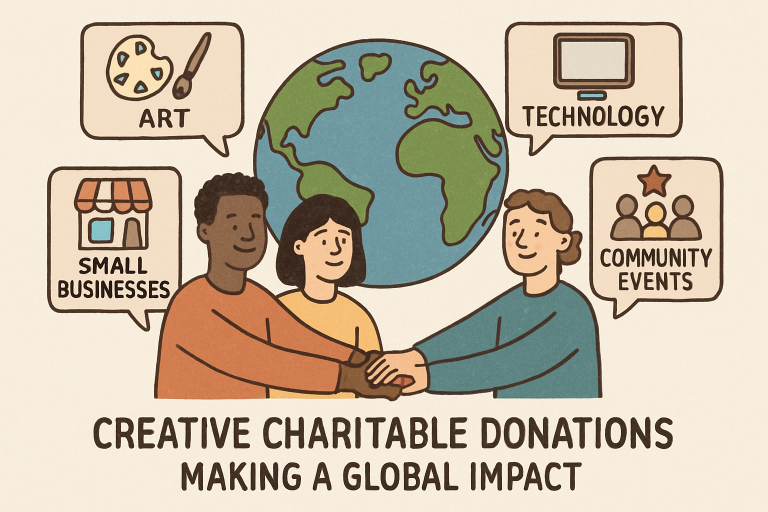Creative Ways Charitable Donations Transform Lives
Contents
Key Takeaways
- Engaging donors in creative activities strengthens their connection to the cause and boosts generosity.
- Adopting technology, like blockchain, ensures transparency and builds donor trust.
- Supporting local businesses and artisans through donations fuels economic growth and community pride.
- Leveraging digital platforms and social engagement expands reach, especially with younger donors.
Charitable giving has always played a pivotal role in building supportive, resilient communities, but today, creativity is amplifying the power of each gift. In recent years, individuals and organizations have moved beyond simply writing a check. Instead, they are actively seeking new and inventive avenues to give back. Donors are embracing innovative strategies that deepen connections, personalize the giving experience, and spark genuine, lasting change. From engaging hands-on projects to leveraging technology for transparency, today’s approaches to giving are making philanthropy far more meaningful. Whether you’re contributing locally or supporting causes across the globe, exploring new approaches to charitable donations can redefine philanthropy and maximize its impact for both recipients and donors. It’s an exciting era where each contribution can be thoughtfully tailored to address unique needs, resulting in donations that foster a stronger sense of partnership and mutual growth.
The evolution of charitable giving means harnessing fresh ideas to tackle longstanding challenges. Instead of just funding immediate needs, donors and charities are collaborating on creative ways to build lasting solutions. Technology, community initiatives, and engaging fundraisers are converging to make giving not only more transparent and secure but also more enjoyable and rewarding for everyone involved. For instance, the advent of online fundraising platforms, blockchain for tracking donations, and interactive art-driven campaigns are transforming how people perceive and participate in giving. From leveraging blockchain for transparency to using art to bond donors with causes, there are endless opportunities to support communities and change lives for the better. The result is a modern philanthropic landscape where empowerment, accountability, and innovation work hand in hand to drive deep social impact.
Beyond traditional cash gifts, individuals are exploring diverse charity donation options to address community needs, offering everything from professional expertise to support for neighborhood entrepreneurs. Donors now recognize that non-monetary contributions—such as time, skills, goods, or access to networks—can be just as impactful as financial gifts. By tailoring their donations to address what communities need most directly, givers are building relationships that go far beyond a single transaction. These new models of giving are making a difference in ways that are both innovative and deeply personal, helping to tackle root causes and empower recipients toward self-sufficiency.
Engaging Donors Through Creativity
Donor engagement is at its most powerful when it taps into creativity. Recent studies show that when donors participate in artistic endeavors—such as painting murals, baking for a cause, or creating event memorabilia—they feel a stronger sense of ownership and connection to the cause. For many, these creative engagements offer a refreshing break from routine, transforming the act of giving into a joyful, memorable experience. The emotional uplift and autonomy these activities provide often lead to higher donation rates and more enthusiastic repeat donors. Nonprofits are increasingly hosting art workshops, collaborative community projects, or creative competitions, each of which helps participants see the real-world results of their contribution. Engaging donors with hands-on experiences encourages ongoing support and makes philanthropy an experience, not just a transaction. This participatory model also gives supporters a tangible connection to the work being done, often leading to long-term advocacy and word-of-mouth promotion of the cause.
Leveraging Technology for Transparency
Trust is a cornerstone of successful philanthropy, and technology is revolutionizing how it’s earned and maintained. Modern donors want the assurance that their contributions are used efficiently and ethically. Blockchain advancements and smart contracts are providing unprecedented security for charity transactions, enabling donors to see in real time how their gifts are used. These systems make it virtually impossible for funds to be misallocated or lost, ensuring that donations reach their intended destinations. These innovations mean greater accountability for nonprofits and increased confidence among supporters, ensuring more donations go directly to those in need.
Additionally, digital giving tools reduce paperwork, streamline reporting, and offer automated updates to donors, building a more engaging and transparent relationship. With streamlined digital tools, the administrative burden is reduced, freeing charities to focus resources where they matter most. Transparency not only satisfies regulatory requirements, but also forges a stronger emotional connection between charities and their supporters.

Supporting Local Businesses and Artisans
Directing charitable donations toward local businesses and artisans generates a ripple effect of benefits. When charities purchase goods and services from local entrepreneurs—especially small, minority-owned, or women-led enterprises—they infuse the local economy with money and foster neighborhood pride. Such giving often encourages sustainable development and strengthens the social fabric, helping communities become more self-reliant and vibrant. By choosing to source products for fundraisers from area artisans or collaborating with local service providers, charities consciously nurture talent and enterprise close to home. This approach cultivates partnerships, supports jobs, and can even inspire recipients to pay it forward by creating their own enterprises or community initiatives. Supporting small businesses through charity creates a cycle of investment that builds community wealth and confidence, ultimately making neighborhoods stronger and more connected.
Organizing Community Fundraisers
Community-focused events(like bake sales, fun runs, and art auctions) do more than raise funds. They foster unity, encourage participation from all walks of life, and create space for dialogue and support. These shared experiences offer an invitation to give and inspire others by demonstrating the collective power of community action. Flexible fundraising events can also adapt to cultural needs, celebration traditions, or local issues, drawing on participants’ creativity and making philanthropy a unique reflection of each neighborhood. The social interaction at these events enhances donor satisfaction and long-term involvement, as people who feel they belong to a cause are more likely to continue supporting the cause. In addition, these gatherings often raise awareness of important issues and encourage the sharing of stories—a powerful way to promote empathy, understanding, and future engagement.
Donating Skills and Expertise
Giving isn’t always monetary. Donating professional skills—such as marketing, financial planning, tech support, or legal consulting—can be invaluable to nonprofit organizations with limited resources. Volunteers who contribute their expertise directly strengthen a charity’s operations, expanding its capacity and enabling more efficient and far-reaching service. Skill-based volunteering ensures that essential services—such as web development or grant writing—are professionally managed, allowing the organizations to achieve more with fewer funds. Such skill-based support often results in lasting improvements to organizational effectiveness, helping charities build strong infrastructure and sustainable futures. Professionals also gain the satisfaction of making a personal impact and, often, growing their own skills through diverse real-world challenges and collaborations.
Embracing Digital Platforms
Digital innovation has redefined the landscape of charitable giving. Crowdfunding websites, social media campaigns, and virtual events make it easier than ever to contribute from anywhere in the world. These platforms foster engagement, particularly among younger, tech-savvy donors who look for seamless, interactive giving experiences. Viral fundraising challenges, creative social media storytelling, and influencer partnerships enable messages to reach larger audiences quickly and authentically. Strategies like peer-to-peer fundraising and online giving campaigns are helping charities reach new supporters and build diverse, sustainable bases of support. Digital platforms also simplify recurring donations and volunteer signups, keeping donors engaged over time and making generosity a visible, shared aspect of modern life.
Conclusion
By taking a creative and adaptive approach to charitable donations, individuals and organizations can magnify the positive change their giving brings. Whether it’s through interactive experiences, technology-driven transparency, supporting local economies, or harnessing the power of digital networks, every innovative step strengthens communities and nourishes hope for a brighter tomorrow. The future of philanthropy is colorful, dynamic, and filled with opportunities to make a meaningful difference through ongoing creativity and collaboration. As we continue to rethink how and why we give, we ensure that every act of generosity becomes a catalyst for lasting transformation—in both the lives of those who receive and those who give.

